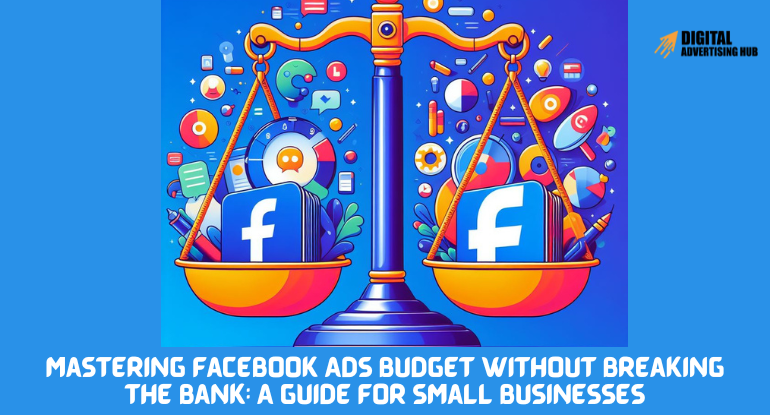Introduction
Running ads on Facebook when you’re a small business can be pretty tough. It’s like trying to handle a lot of things at once while balancing on a unicycle and juggling flaming chainsaws. You’ve got big dreams, but there’s not a lot of money to spare. Plus, there are so many other businesses competing for attention.
But don’t worry, there’s a trick: making the most out of your budget. This isn’t just about getting more clicks for less money. It’s about making every dollar count by getting more in return. It’s like turning a little bit of money into a lot more by making smart choices.
But this isn’t a fairy tale with magic beans. It’s about using some smart strategies and tricks that you won’t find in your usual marketing books.
So, forget about being scared. Get ready like you’re packing a bag for an adventure. We’re going to explore how to do great advertising on Facebook without spending loads of money. We’ll learn, try new things, and succeed!
Excited to learn how to make your Facebook ads work amazingly well without spending too much? Hang tight! In this blog post, we will dive into each of these cool tricks, giving you the know-how to reach your advertising goals, even if you’re on a tight budget!
Understanding Your Facebook Ad Budget: A Practical Guide

Before launching your Facebook ad campaign, let’s talk about budget. Budgeting for Facebook ads isn’t just about throwing around numbers – it’s about investing in results. This guide will explain the different ad budget options and key metrics to track, helping you set budget levels that fuel your campaign towards success.
Types of Facebook Ad Budget
#1 Campaign and ad set budgets
When you’re diving into advertising on platforms like Facebook, understanding the dynamics between campaign and ad set budgets is crucial. Imagine your campaign budget as the total amount of money you’re willing to spend on all your advertising efforts for a particular goal or project. It’s like your overall spending cap for that specific marketing venture.
Within this campaign budget, you have the flexibility to create ad sets. These ad sets are smaller, more targeted groups that allow you to concentrate on specific audiences with tailored ads. They’re like focused segments within your overall campaign, each with its own unique audience, characteristics, and goals.
Now, the beauty lies in the ability to allocate different amounts of money to each ad set. This level of control is incredibly powerful. It enables you to fine-tune and direct your spending precisely where you believe it will have the most impact.
Why is this targeted approach so important?
#1. Relevance and Engagement: Instead of throwing the same ad at everyone, you can tailor messages and visuals to each audience based on their interests and demographics. For instance, let’s say you’re promoting a new line of fitness apparel.
You might create different ad sets to target fitness enthusiasts interested in yoga, weightlifting, and running. Each ad set would have its own budget allocation, allowing you to invest more in the audience segment that seems most likely to respond positively to your ads.
#2. Budget Optimization: You can adjust spending based on performance. Putting more money into ad sets that are generating lots of clicks and conversions makes your budget work harder. On the other hand, you can reduce spending for sets that aren’t performing well, preventing wasted resources.
#3. Testing and Refinement: Experimenting with different ad creatives and targeting options is easier with ad sets. You can test different approaches for each group and quickly adapt your overall campaign based on what works best.
Here are the different ad set budget options you have:
I. Shared Budget: All ad sets within your campaign draw from the same pool of money. This works well for smaller campaigns or when your audiences have similar characteristics.
II. Individual Budget: Assign specific amounts to each ad set, giving you fine-grained control over spending. This is ideal for diverse audiences or when you want to prioritize certain segments.
III. Dynamic Budgets: Facebook automatically distributes your budget across ad sets based on their predicted performance. This requires trusting the algorithm but can optimize spending for maximum reach and conversions.
In essence, the campaign budget sets the total spending limit, while the ad sets allow you to strategically distribute that budget to maximize the impact of your advertising efforts by focusing on specific audiences and their preferences.
This approach ensures efficient spending and helps in achieving better results by tailoring your ads to different segments within your overall target audience.
#2 Lifetime vs. Daily Budgets
Deciding how to spend your Facebook ad budget? Your choice boils down to two main options: lifetime budgets and daily budgets.
- Lifetime budgets: Think of it as a slow, steady drip, spreading your investment over the entire campaign duration. This option is ideal for long-term goals like brand awareness or ongoing lead generation. It ensures consistent spending but might not be as flexible if you need to adjust quickly.
- Daily budgets: Imagine short bursts of spending, allocating a set amount each day. This works well for short-term campaigns like flash sales or testing different ad variations. Daily budgets offer flexibility but might not reach as wide an audience as lifetime budgets over time.
Choosing the right budget type depends on several factors:
- Campaign duration: Lifetime budgets are better for longer campaigns, while daily budgets suit shorter ones.
- Spending consistency: Do you prefer a steady flow or bursts of spending?
- Flexibility: How quickly might you need to adjust your budget during the campaign?
For example, a local bakery running a weekend discount campaign might choose a daily budget, while a clothing brand building brand awareness across several months might opt for a lifetime budget.
Ultimately, the best budget type is the one that aligns with your specific campaign goals and budget allocation strategy. Don’t hesitate to experiment and adjust your approach to maximize your advertising success!
How to Set Your Initial Budget Level

Determining how much to spend on your ad campaign can be challenging. While industry benchmarks provide a starting point, your specific business goals should be your primary guide.
#1. Business Goals as a Guide: Are you looking to create brand awareness or drive immediate sales? If your focus is on brand building, a smaller test budget might be sufficient to gauge initial reactions. However, if your goal is immediate sales, you might need a more substantial investment to reach and convert a larger audience.
#2. Testing and Optimization: It’s often beneficial to start with a conservative budget, especially if you’re testing a new campaign or strategy. As you gather data and understand how your ads perform, you can adjust your budget levels based on the metrics that matter most to your objectives, gradually optimizing for better results.
Key Budget-related Metrics to track
When you’re running ad campaigns, keeping track of key metrics is like having a roadmap through a jungle of data. These metrics give you insights into how your ads are performing and guide your decisions on what’s working and what needs improvement.

#1. Impressions: This metric tells you how many times your ad was displayed to users. It’s like the number of people who had the opportunity to see your advertisement in their feed or on a website.
#2. Clicks: Clicks indicate how many people actually engaged with your ad by clicking on it. These individuals have entered your conversion funnel, showing interest in your offer or content.
#3. Conversions: The ultimate goal of your campaign. This metric tracks every action that aligns with your campaign objective, such as making a purchase, signing up for a newsletter, or downloading content directly attributable to your ad.
#4. Cost per Result: This metric calculates the average cost you incur for each desired action or conversion. For instance, it could be the average cost per click that ultimately leads to a sale or any other specific outcome you’re tracking.
Remember, these metrics and budget considerations aren’t set in stone. They provide a starting point and a framework for analyzing your campaign’s performance. Flexibility and adaptability are key as you navigate through your advertising journey, tweaking budgets and strategies based on real-time data and your evolving business goals.
Start small, experiment, and track your metrics closely. Use your data to adjust your budget, targeting, and creatives like a scientist refining their experiment. Your Facebook ad budget is a living thing, constantly evolving to deliver the best results.
Best Strategies to Increase Your Facebook Ads Performance with Low Budget
#1. Picking the Right Time and People: This is one of the smartest strategies to increasing your Facebook ads conversion. Imagine you’re advertising a new line of fitness gear. You know your target audience—fitness enthusiasts—scroll through social media during specific times, like lunch breaks or in the evenings after work.
By scheduling your ads to appear during these peak times, you increase the chances of catching their attention when they’re most likely to engage.
For example, you run a series of ads showcasing your fitness gear around 12 PM and 6 PM. Your data reveals a higher click-through rate during these periods, indicating better engagement from your target audience.
#2. Testing and Making Ads Better: This requires you to often experiment with different ad formats, visuals, or messages to determine what resonates best with your audience. It’s like a trial-and-error process to create ads that are so compelling, people can’t help but click.
For instance, you create two versions of an ad—one with a lifestyle image and another with a product close-up. After running both, you notice the lifestyle image ad receives more clicks, indicating it’s more appealing to your audience.
#3. Finding Similar Audiences and Bringing People Back: Advanced tools allow advertisers to identify audiences similar to their existing customers. This means discovering new potential customers who share characteristics with your current buyers.
Additionally, good retargeting strategies remind users who’ve interacted with your brand but haven’t made a purchase yet, nudging them back to your site.
As an illustration, you use a lookalike audience feature to target users who share traits with your current customers. These new users show a similar interest in fitness and demonstrate a higher likelihood of engaging with your ads.
#4. Using Data and Changing Tactics: Behind every click or view lies valuable data for you to use. It is very crucial to analyze this information to understand what’s working and what needs adjustment. Then adapt your strategies based on these insights, aligning your ads more closely with audience preferences.
For example, you notice a specific demographic engaging more with video ads than static images. You shift your strategy to focus more on video content, catering to the preferences of your audience and boosting engagement.
By leveraging these strategies, you can refine your targeting, create more compelling ads, and adapt to audience preferences, ultimately optimizing your campaigns for better performance and higher conversions.
How to Calculate Your CPM, CTR, and Conversion Rates Yourself
Running Facebook ads is exciting, but understanding their performance is crucial for success. Three key metrics – CPM (cost per mille), CTR (click-through rate), and conversion rate – paint a valuable picture of your ad’s effectiveness. Knowing how to calculate them yourself empowers you to analyze your results and optimize your campaigns for maximum impact.
#1. CPM: Counting Costs per Impression
Think of impressions as your ad’s “eyeballs”. CPM tells you how much you pay for every 1,000 impressions of your ad. Here’s how to calculate it:
- Total Campaign Spend: Track the total amount of money you spent on your ad campaign.
- Total Impressions: Find the number of times your ad was displayed in Facebook Ads Manager.
- Formula: CPM = (Total Campaign Spend) / (Total Impressions) × 1,000
For example, if you spent $20 and your ad received 5,000 impressions, your CPM would be: CPM = ($20) / (5,000) × 1,000 = $4.
We have a free CPM calculator for you.
#2. CTR: Measuring Click-Worthiness
CTR reveals how many people clicked on your ad after seeing it. It reflects the ad’s ability to capture attention and spark curiosity. Here’s the calculation:
- Total Clicks: Find the number of clicks your ad received in Facebook Ads Manager.
- Total Impressions: Remember the number of times your ad was displayed.
- Formula: CTR = (Total Clicks) / (Total Impressions) × 100
Let’s say your ad received 100 clicks from those 5,000 impressions: CTR = (100) / (5,000) × 100 = 2% Alternatively, you can check our free CTR calculator.
#3. Conversion Rate
The ultimate goal is conversions – be it purchases, sign-ups, or downloads. Conversion rate tells you what percentage of your ad viewers actually took the desired action. Here’s how to calculate it:
- Total Conversions: Find the number of desired actions completed from your ad in Facebook Ads Manager.
- Total Clicks: Remember the number of people who clicked on your ad.
- Formula: Conversion Rate = (Total Conversions) / (Total Clicks) × 100
If your ad led to 20 conversions from those 100 clicks, your conversion rate would be: Conversion Rate = (20) / (100) × 100 = 20%
It should be noted that Facebook Ads Manager automatically calculates these metrics for you. However, understanding the calculations empowers you to analyze your results independently and adjust your campaigns with confidence.
Keep in mind that comparing your metrics to industry benchmarks can offer valuable context. Regularly track these rates and experiment with your ad creatives, targeting, and budgets to optimize your campaigns for better performance.
Conclusion
Effective Facebook advertising on a budget is a strategic blend of targeting, creativity, and data analysis. Mastering your Facebook ad budget isn’t just about saving money; it’s about maximizing results.
Embrace the power of data, refine your strategies, and watch your ROI climb. The future of advertising is data-driven, and with these insights, your small business will be at the forefront of success.
Flexibility, adaptation, and constant optimization are the cornerstones of success in navigating the dynamic landscape of Facebook advertising. Take charge of your Facebook ads from today. Remember to share your challenges and best tips in the comments below.






